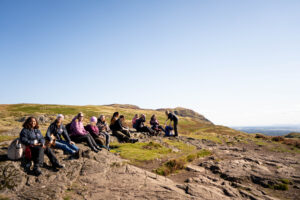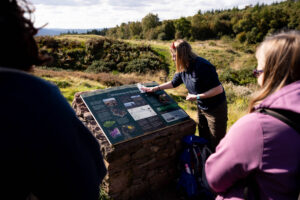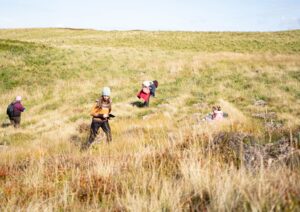Learning from the land: A visit to Drumbrae

Who says teachers need to be human? During a Sustainability Champions excursion to one of the University’s reforestation sites, the visitors ponder Drumbrae’s landscape, history and ecology, and how it might shape the University even as the University transforms it. PhD candidate Lisi Angerer tells the story.
It takes a good half hour from the High School Yards to get out of Edinburgh.”I’ve seen fields on both sides”, announces Chloe at last. ”Now we’ve officially left the city!” As the coach speeds along the highway, we wonder who we are to the place that we’re about to see. “From the perspective of the forest, we’re just these tiny little beings passing through for the speck of a moment in its first year of life.”
But just as a forest begins, a much longer chapter is coming to an end. Take the last century and you see what many Scots will call homely: Rolling hills, seemingly bare, save for bracken and the occasional scattering of trees huddled around their feet. A reservoir, reflecting the sky in a steel blue disc, striking against the golden-brown early autumn hues of ferns and mosses. 
I say, “seemingly bare”. Of course, these hills appear so only from afar. From close up, feeling our way carefully along the uneven, boggy ground, we are surrounded by the quiet bustle of small organisms, an entire ecosystem below knee height. Where once was woodland now lives what can thrive in the open. And that is only the surface view; how much more still lives in the unseen underground, adapted to the soil composition of a treeless landscape, feasting, perhaps, on the remains of long deceased mighty roots.

Julie, the Community Ranger for the University’s Forest and Peatland Programme, tells us snippets of the story of Scotland’s landscape, transformed by farming, hunting and the industrial revolution. Trees were felled in favour of sheep and cattle grazing spaces. Predators such as wolves and lynx were hunted to extinction, tipping the deer population out of control. Sporting estates further encouraged deer overpopulation for hunting pleasure.
“Young trees are tasty to deer because they like young fresh foliage and buds. Any trees that pop up through natural regeneration tend to get browsed by deer. The fences are needed to protect the newly planted trees and that also helps with the natural regeneration we are now seeing here”, explains Julie, pointing out relatively new fences of wood and mesh running along either side of the path we took on the way up here.
“ It is quite a process installing fences. It takes a lot of consulting with the local communities, because the fences change their experience of the landscape. With good placement, usually people get used to the fences. Sometimes you find people will complain when you take them down in 10-15 years time, when the woodland can handle a bit of deer browsing.”
The fences are just one example of different opinions crossing paths on this land. The solution here is to ensure that the fences are not visible from the most popular viewpoints, and to display signs in relevant locations to help people find their way to the gates and out of the fenced areas. (Relatively) practical problems with very practical solutions.
But it gets far more complicated still. For instance, what counts as ‘natural’? What we feel as natural in a landscape is deeply infused with what we consider normal.
“Across the different places and projects you’ve worked in, is there a common challenge you think that Scotland is facing with regards to reforestation?”, Lauren asks Julie over lunch. We are perched in a happy row alongside a rocky path underlining the panoramic view beyond.
Julie doesn’t need to think for even a second: “Oh, yes! The main obstacle is that people are used to a landscape without trees. By now, multiple generations have grown up in a Scotland with barely any forests. It’s hard for people to imagine that changing. It creates difficult emotions.”
The sun shines warm on our faces and layers are coming off. We munch on our sandwiches, silenced for a while by the spectacular outlook onto Stirling sprawling to the South of Drumbrae. Right in front of us, almost graspable, the Hermitage woods, which I know well from the inside but have never seen from above, where it looks like so much less than what it is, making me think about the inadequacy of satellite images at showing the world. Half sheltered behind these woods lies the University of Stirling, overlooked to the left by the Wallace monument, calling to mind the eerie beauty of a rotting tree trunk. On a hill further to the right sits Stirling castle, its bright yellow unusually subdued today by some inscrutable conditions in the quality and angle of the light. And around it, soft sloping, naked hills as far as the eye can see.

“Everyone has a ‘mother ecology’”, says Sam to me on the way back down, thinking still of Julie’s words during lunch. “Your mother ecology is the landscape and climate in which you’ve grown up and feel at home. The plants and animals you’re familiar with, the colours and shapes of the land and sky, the way the air feels, the way the light falls…”
“Oh yes”, I nod, “I know what you mean! I have that in the Austrian Alpes. It’s where my body belongs and it knows that.” I try to imagine what it is like, someone telling you that your mother ecology is actually an unhealthy one, an impoverished ecology that should be transformed. Telling you that a defining feature of the landscapes you’ve known and loved all your life needs to change.
I’m beginning to understand just the smallest fraction of the scope of Julie’s work as a community ranger here, and then I think of the University’s communication team’s work. How do you tell the infinite interwoven stories tugging at Drumbrae in something so linear and flat as a blog post, a report, or a news article?

Halfway down the slope, we pause in front of a large sign mounted on a stone plinth. “Look at that, it’s gotten grimy already! ”. Julie immediately goes about cleaning the sign. As tales and pictures of a rare butterfly and the flowers it feeds on regain their colour and shine, she tells us about the volunteer in a nearby town who is growing these flowers in his greenhouse. They will soon be reintroduced to the Drumbrae site, where they have long disappeared due to sheep grazing.
The Northern Brown Argus butterfly has recently been sighted in Stirling for the first time in a hundred years, and together we wonder how the first brave specimens went about detecting the reappearance of their feeding flowers in the area, and whether butterflies communicate about food sources the way bees do.
“We want students to come out here and study these species. But this place is not just interesting for biology students, we also hope to see arts classes come here. Oh, and we’re planning to put up sound monitors so we can detect what birds are present on site – you’ll be able to see that in real time once the system is up and running! There’s an outdoor learning facility in the making with a classroom space…” Julie goes on, listing the ways in which Drumbrae will become a site of encounters between species – humans alongside rarer kinds.
“I wonder…”, one of the sustainability champions ventures, “I mean, this sounds like it’s about so much more than just carbon sequestering!”
“Yes”, Julie nods emphatically, “absolutely. Carbon sequestering is just one of the things going on at Drumbrae.”
“But is that known across the University?”, continues the inquirer cautiously. “I feel like the messaging about Drumbrae is mainly about CO2 reduction, or at least that’s what seems to be most widely known across the University, and some of the staff are actually not too much on board with that way of looking at it.”
“Well, carbon sequestering was the main aim at first. That’s because it was the most predictable outcome of the forests and peatlands programme and directly related to the University’s goal of reaching net zero by 2040. We couldn’t know up front how the local communities would respond and want to use the space, and how staff and students would engage with it… But we always intended for Drumbrae to be a place of nature restoration, learning, teaching and research. We’re really trying to communicate all that, but it’s difficult to do the ambition and scope of the programme justice.”
I’m deep in thought as I regard Julie and the rest of the group, all of us standing on this hillside that has come under the decision-making power and care of the University so recently, has been purchased, surveyed, dug up, planted, discussed and surely also fought over, admired, loved, and traversed by so many for so long.
This place, I begin to realise, is not just ‘owned by’ the University – if places can be owned at all. Drumbrae is part of the University now, and this means that it takes part in shaping what the University is. Who says a university consists of buildings filled with screens and whiteboards, books, tables, and chairs? Why not hills instead – hills with mosses, ferns, lichen, butterflies, flowers, and slowly growing trees? Who says teachers need to be human?






Drumbrae – a Living Laboratory!